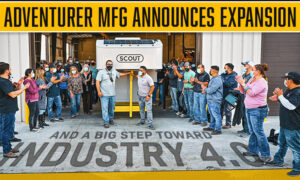In 1971, Dan Daddieco drove to Alaska in a VW Beetle. 45 years later, Dan returned to Alaska with his wife, Sheri. For this trip, Dan brought something a little more robust and luxurious.

In 1971, thousands of RVers went to Alaska. Not one of them brought a cell phone or a GPS. They relied on research gleamed from printed books and magazine articles, stopped at their local AAA for information, made long distance phone calls to Alaska tourism offices asking for brochures, and studied huge folded paper maps. If they were lucky, they had friends that had gone before who shared their tips and experience.
If I double-dog-dared folks to take a trip to Alaska without a cell phone, GPS, or internet service in 2017, they would tell me I’m nuts.
That would be too dangerous! What would you do if you broke down, were attacked by wild bears, or – heavens to betsy – got lost? Most folks can’t go to the bathroom without their smartphone, much less Alaska.
Of course nobody thought this way in 1971. No one worried about not having a cell phone or GPS. They didn’t exist, and they had the aforementioned maps, knew how to use them, and the faith that fellow travelers would stop and help – if needed.
To the best of our knowledge, most of the 1971 Alaska-bound RVers made it, had fun, and came back unscathed. Maybe one or two were eaten by bears, but that would have happened anyway.
For those who are struggling with the idea of not traveling with a cell phone or GPS, let’s up the ante. Not only do you not have a cell phone or GPS, but your trusty vehicle is none other than a Volkswagen Beetle.
What! Alaska in a VW Beetle? You might as well walk there up hill, both ways, in the snow! No one could possibly survive such a completely insane and irresponsible journey.
This is all news to Dan Daddieco. Not only did Dan go to Alaska in a Volkswagen Beetle in 1971, but he sure as heck didn’t have a cell phone or GPS. And, as you’re about to read, he lived to tell the tale.
As big adventures tend to do in your twenties, Dan’s Alaska adventure made a profound impression – so much in fact that he long dreamed of returning, this time with his wife.
After forty five years of hard work, saving, and planning, Dan and Sheri drove to Alaska in his 70’s Beetle tracks. Only this time they were in something a bit more robust and luxurious than Dan’s VW.
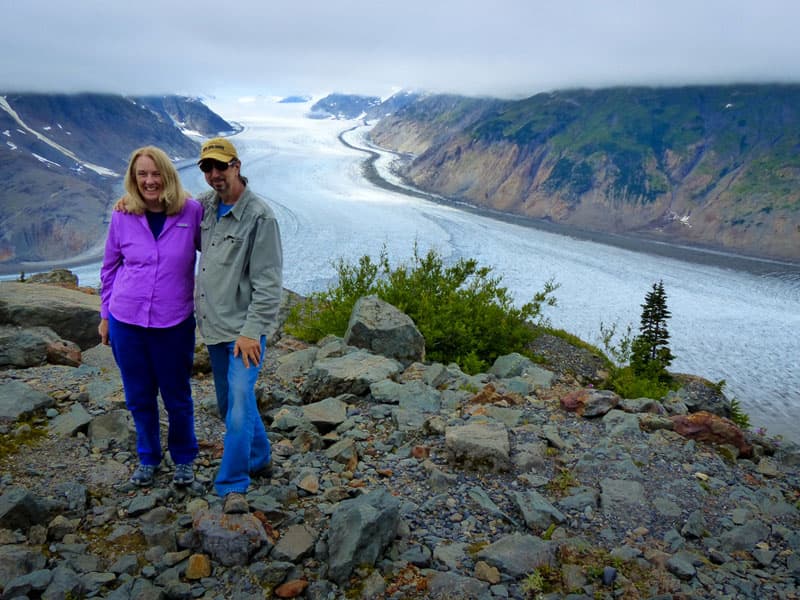
Above: Sheri and Dan in Hyder at Salmon Glacier
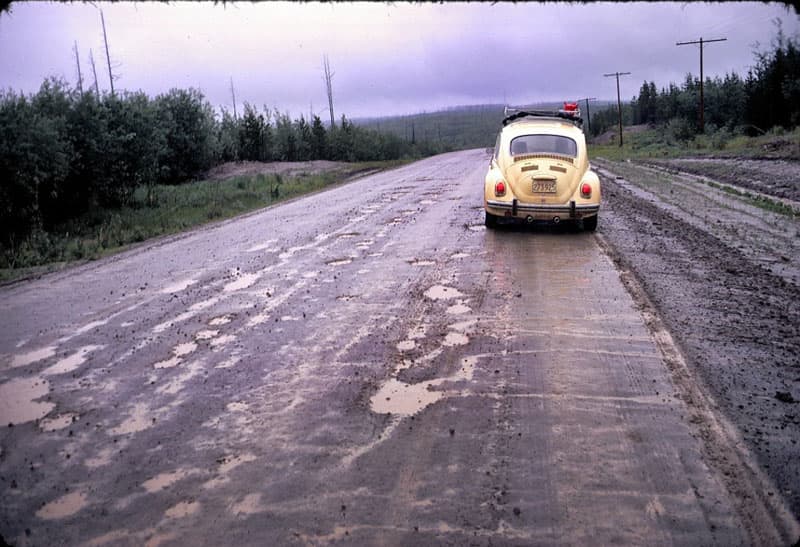
Above: Dan’s VW Beetle in Alaska
TCM: Take us back in time to 45 years ago and tell us the story of how you came to drive up to Alaska in a VW Beetle.
Dan: It was 1971 and I was 21 years old. I had just gotten married to my first wife after I graduated from college. The Beetle is the car that I was driving as a student, so it was a very cheap form of transportation. Knowing that we wanted to take a cross-country trip ending up in Fairbanks, we outfitted it to survive the Alaska Highway, which back then was 1200 miles of dirt, dust, mud and endless potholes.
The Alaska Highway is completely paved now, but it does have construction areas. Frost heaves destroy the asphalt, so they are always repairing the road. Anybody who goes to Alaska should expect to be on gravel one or more miles at a time here and there. It’s not a big deal.
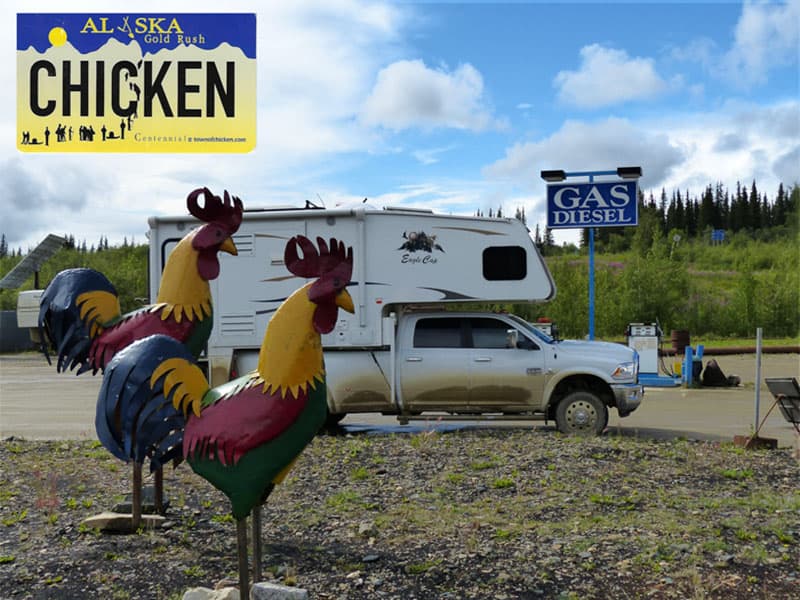
Above: Their muddy camper in Chicken, Alaska
Once you leave the Alaska Highway to traverse the Top of the World Highway or Denali Highway, it will be all gravel. June is the rainy season when you may get muddy roads. It’s hard to keep your camper clean in Alaska. We tried to keep our rig clean and then gave up. The picture I sent from Chicken, Alaska shows what it looked like for the rest of our journey.
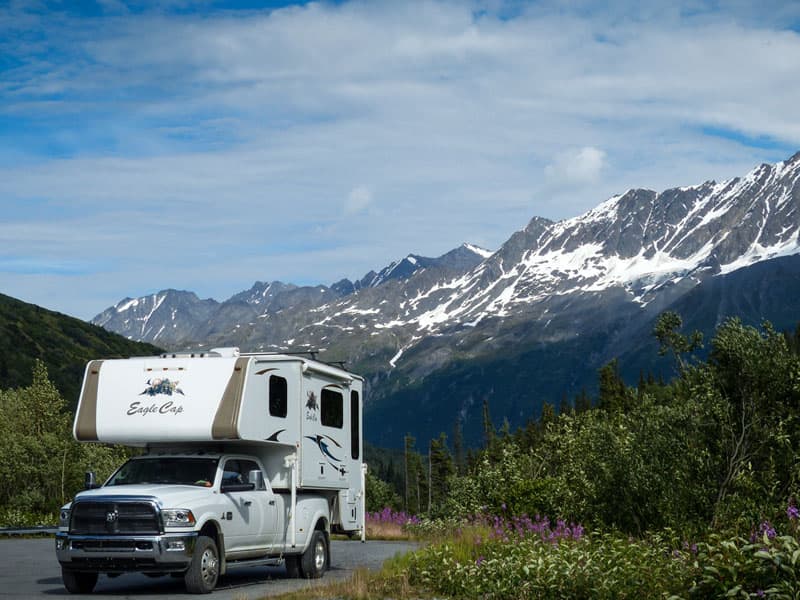
Above: Thompson Pass, Chugach Mountains northeast of Valdez, Alaska
TCM: You’ve told us that Alaska was a trip of a lifetime, but you had already been to Alaska in 1971. What made you want to go back all these years later in a truck camper?
Dan: I have always wanted to go back. Sheri is an adventurer, so it was easy to talk her into going on the trip. The hard part was figuring out what type of RV to take. After doing all our due diligence, we came up with idea of purchasing a truck and camper.
Sheri: We decided that a truck camper would provide the most agility to maneuver the roads of Alaska. In the 1990s, we had a 30-foot Holiday Rambler fifth wheel. We enjoyed the ability to detach the truck and have a touring vehicle, but wanted a smaller footprint for Alaska and our current lifestyle.
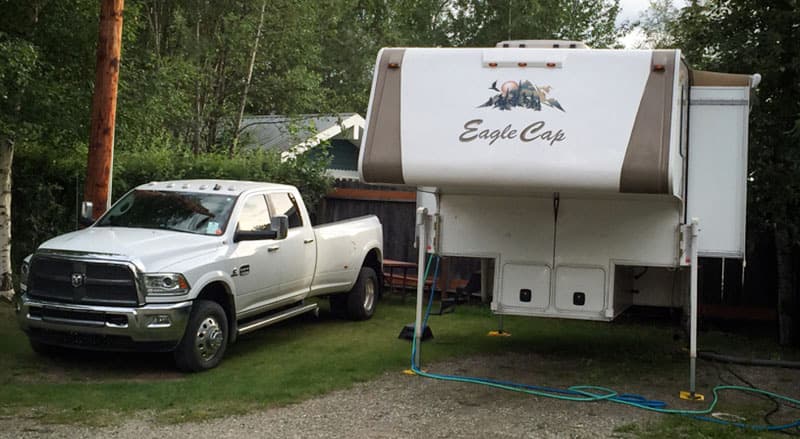
Above: Dan and Sheri like to take their camper off, and use their truck to sightsee
Dan: Because of the smaller footprint we can go anywhere our truck can go. We did not want to have to be restricted to the paved highways and the typical tourist spots. We wanted to venture out to the places and scenic roads less traveled.
We were amazed at how many truck campers were out in Alaska compared to here in Arkansas. It seemed like 20-percent of the RVs were truck campers.
Sheri: We saw lots of motorhomes pulling cars, but they weren’t going where we were going.
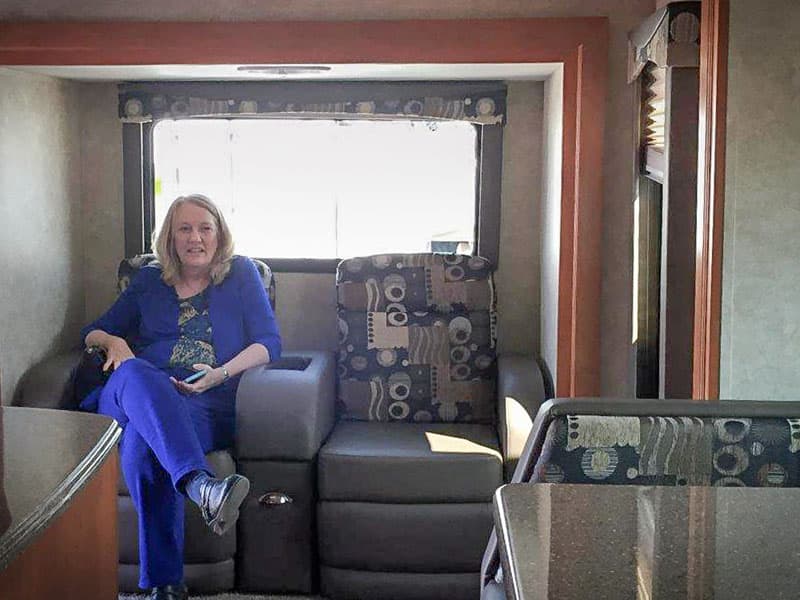
Above: Sheri sitting in a recliner of their Eagle Cap 1165
TCM: So why did you choose the Eagle Cap 1165?
Dan: There were several key factors that made the Eagle Cap 1165 our top choice; four-season construction, comfort, size, functionality, and maneuverability. The three slide-outs provide ample floor space, and the recliners and dry bath were two features that made the 1165 model particularly attractive. Being able to collapse into those comfortable recliners at the end of a long hard-driving day was a great relief.
In the spring of 2015, we purchased the truck camper and a 2015 Ram 3500. We added Torklift StableLoads and air bags to support and balance the load. We took our first long trip to New England and Nova Scotia that summer to work out any kinks and learn the ropes of traveling with a truck camper.
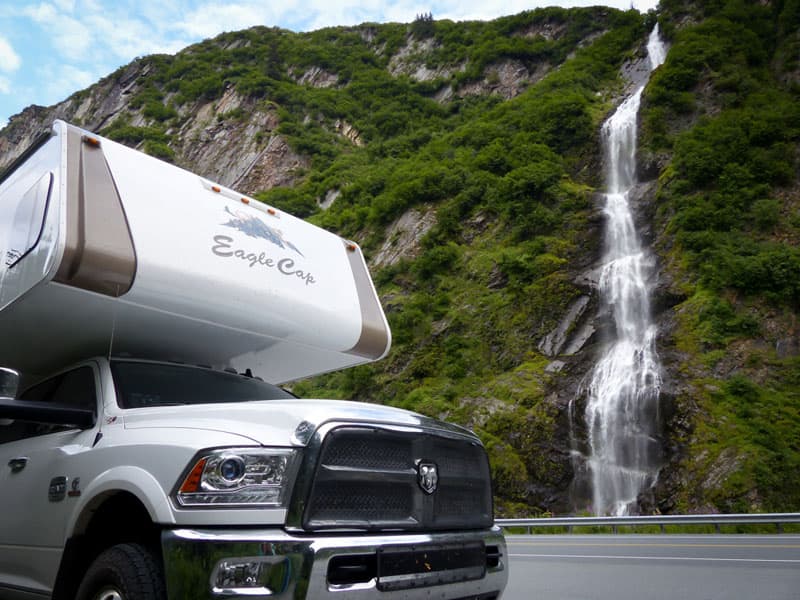
Above: Bridal Falls, Valdez, Alaska
TCM: Did you do anything to prepare for the trip?
Dan: Anybody who goes to Alaska shouldn’t go there on a defined schedule. It’s hard to tell anybody how big Alaska is, and that doesn’t include the Yukon and British Columbia.
It’s so hard to comprehend the vastness. It took us two to three days to travel what we thought would take one day. Go without any preconceived notions of itinerary.
Sheri: Dan made sure to evaluate the potential points of failure with our camper. For example he brought hand cranks for the Happijacs, a hand-held sonar propane monitor, and an air compressor. We used the air compressor a lot to re-adjust the tires as we traveled between cold and hot weather.
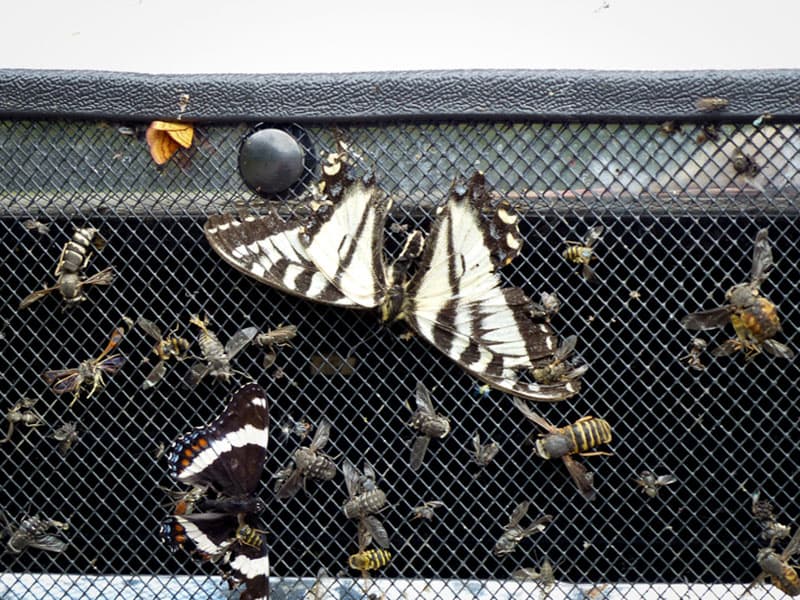
Above: Bug screen on the front of their truck
During our trip, water got into a Happijac jack and shorted out the motor. Luckily, Dan brought a hand crank for the jacks. When we got home we received the replacement jack and Dan sealed all of the casings with silicon. He also bought a refurbished motor to bring next time – just in case. As with any RV trip, be prepared.
TCM: You were originally signed up with an Alaskan tour company. What happened?
Sheri: A concern we had for the Alaska trip was traveling alone on such a long venture. We were thinking it would be best to travel with a group/caravan or someone else for safety and any potentially needed assistance.
Dan initially tried to interest others in creating a small group of RVers to join us. Later he researched Alaska RV tour groups. He signed us up ten months in advance for a sixty day tour that appeared to be the best match.
Unfortunately, two months before our meet up date in Dawson Creek, British Columbia we received a cancellation notice. The other options, all thirty day tours from the various other groups, were already full. That’s when we made the decision to travel on our own.
In retrospect, I believe we enjoyed the trip more being on our own than if we had been in the caravan. We were able to be more flexible with our travels and sightseeing.
TCM: The tour being canceled must have been quite a shock. How did you go about planning your trip once that happened?
Dan: The tour company was kind enough to provide their itinerary to us, so we decided to head out in mid-May. Then Sheri unexpectedly had to part ways with her gall bladder. Fortunately, it delayed rather than canceled our trip.
We headed out in June the minute she got the okay from her doctor. We left home with the expectation that we would take our time on our adventure and stop and enjoy ourselves along the way.
As a side note, we believe the best time to be in Alaska is in early May or late July to avoid the caravans. It’s less crowded at that time. Coming back in late summer and early fall gives you more opportunity to see the fall foliage and more bear activity.
We decided to loosely follow the caravan itinerary and picked and chose the items we wanted to do. We quickly discovered that most of the places listed on their itinerary were spots we found on our own via The Milepost or the helpful folks at the information and visitor’s centers.
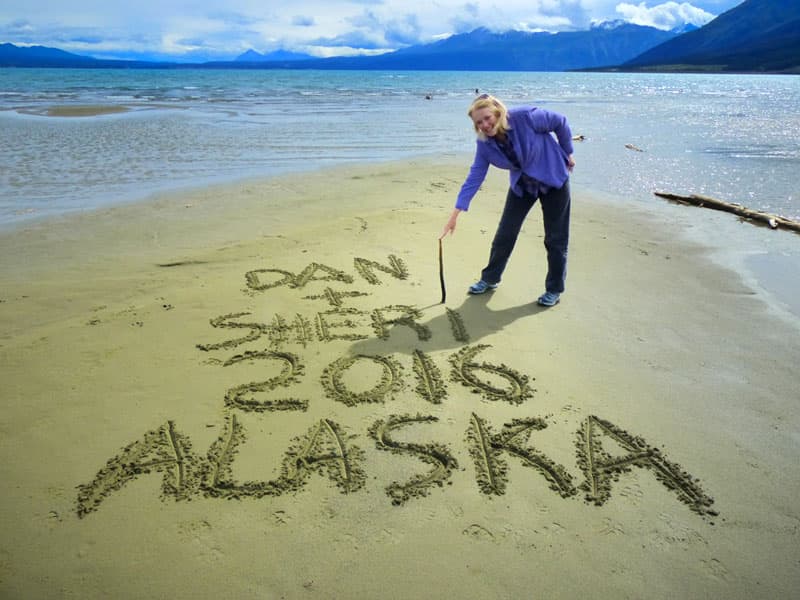
TCM: What was your route to Alaska?
Sheri: Dan picked our route to Dawson Creek, British Columbia and included several short stops at national parks in the United States and Canada.
We enjoyed several brief stops at Badlands National Park, Yellowstone National Park, and Glacier National Park. We had been to the national parks before but, since we were in the area, we stopped in for a quick visit.
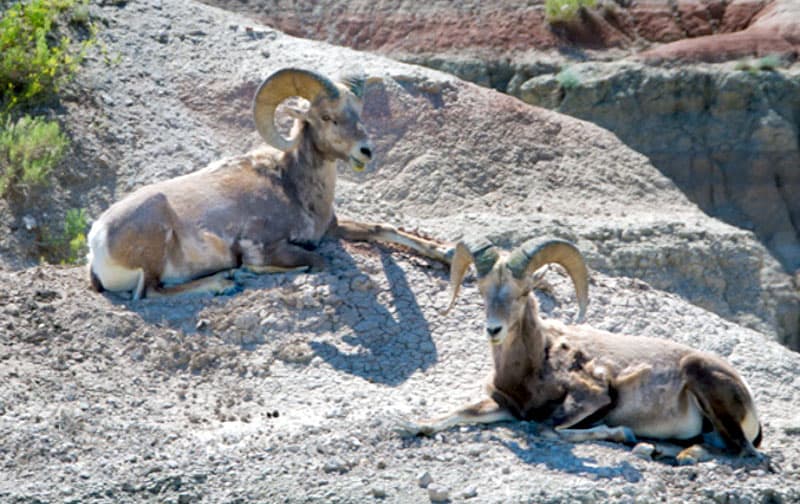
While touring the Badlands National Park we enjoyed seeing a variety of wildlife. We caught ram sheep napping above a canyon with the lovely backdrop of colorful striations in the sandstone.
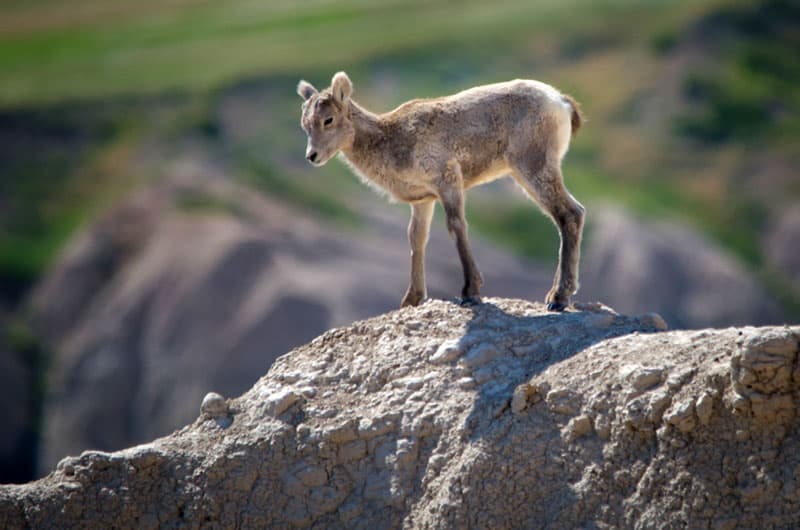
We spent the day viewing a variety of wildlife species. Along the way we encountered an ewe. While taking pictures of her, we experienced a surprise encounter when a lamb popped up from the canyon below to reconnect with its mom.
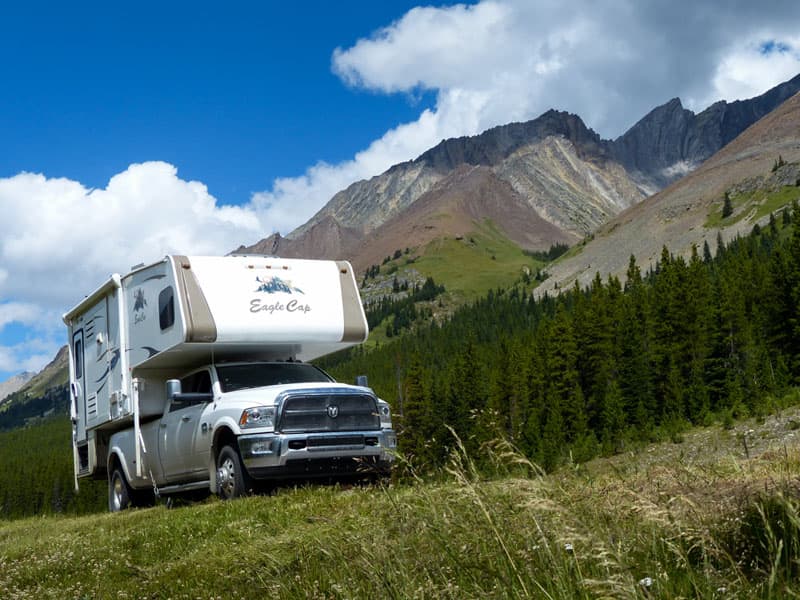
Above: Highway 40 through Kananaskis Country (or K Country) in western Alberta
TCM: Where did you cross into Canada?
Dan: We crossed the border into British Columbia, Canada in Roosville, Montana. We decided to head to Banff National Park and Jasper National Park, and cut through Alberta. An information guide advised us that an especially scenic drive to Banff was up Highway 40 through Kananaskis Country (or K Country) in western Alberta.
K Country has some spectacular areas with crystal clear emerald green lakes. As usual, we stopped at the visitor center to get a more detailed map and advice about scenic stops.
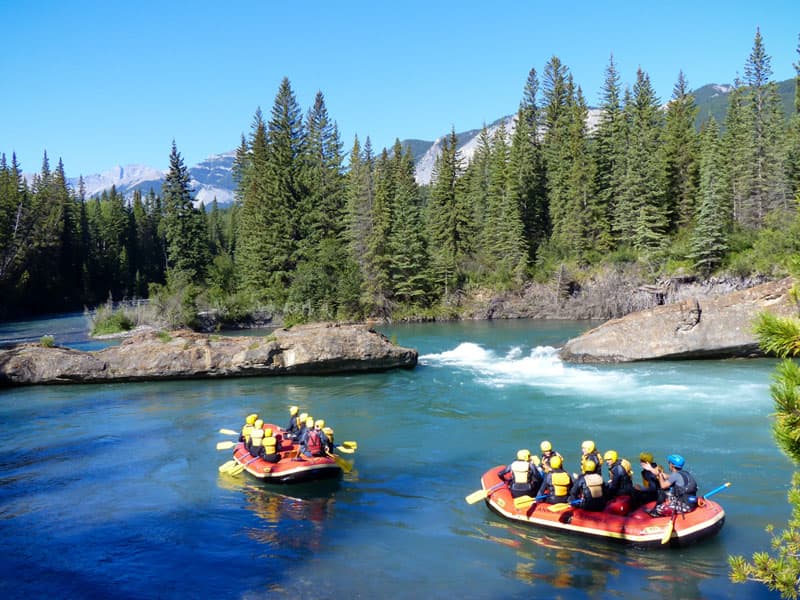
A short walk down a steep path in the woods revealed a beautiful lake with a group of rafters taking lessons. They were learning how to navigate through a narrow passage with a small patch of white water on Barrier Lake. A nice gentleman was on the shore filming and he provided commentary on the exciting exercise.
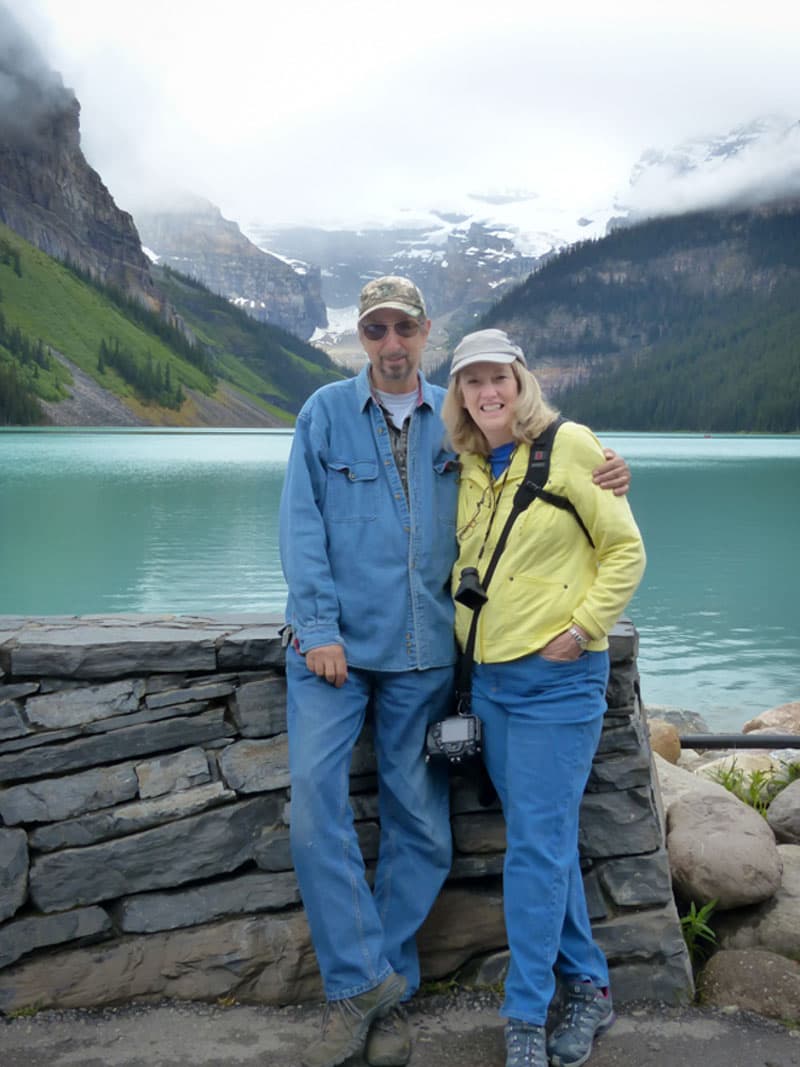
Above: Sheri and Dan standing in front of Lake Louise, Banff National Park
We arrived at Banff, Alberta and took a ride to the emerald green Lake Louise. It was extremely beautiful, although jam packed with people.
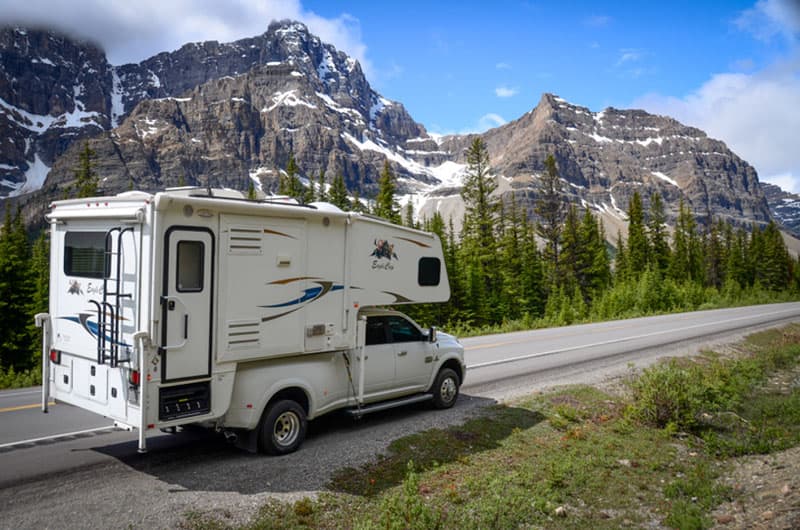
Above: Moraine Lake in Banff
Afterwards we enjoyed a scenic drive up to Moraine Lake in Banff, but it was so crowded that there were no parking spaces forcing us to keep going. We later stopped along the side of the road to enjoy the view.
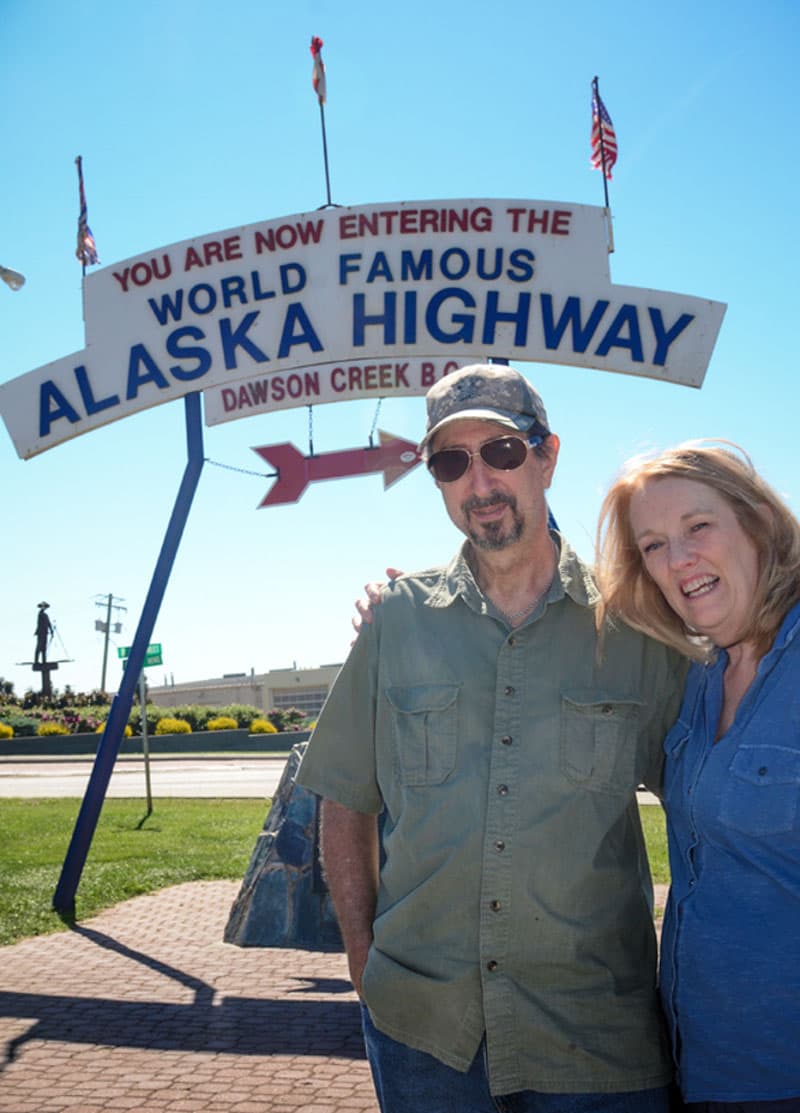
Above: World Famous Alaska Highway memorial in Dawson Creek
Sheri: Upon our arrival to Dawson Creek, British Columbia, we enjoyed some must photograph tourist stops.
To document our start on the Alaskan Highway, we visited the, “World Famous Alaska Highway” memorial and the roundabout in the center of Dawson Creek where the official mile marker zero of the Alcan Highway is located. Then, we headed to some off the beaten path scenic stops.
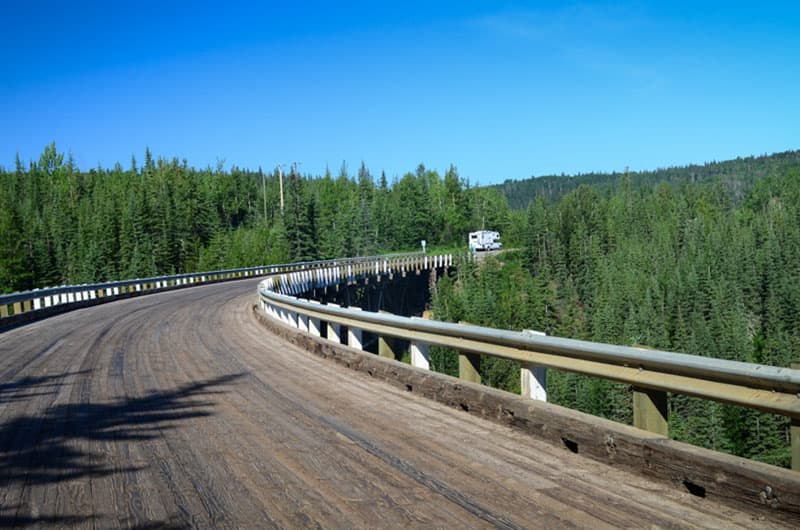
Above: Curved wooden Kiskatinaw Bridge down the Old Alaska Highway
On our way out of Dawson Creek we took a side trip down the Old Alaska Highway to see the curved wooden Kiskatinaw Bridge. Though there were many timber bridges built during the construction of the Alaska Highway, the Kiskatinaw Bridge is the only one still in use. It is also one of the most unusual, curving nine degrees along its 534 foot length. It is 100 feet above the stream below. In 1978 a new road was built that bypassed the bridge.
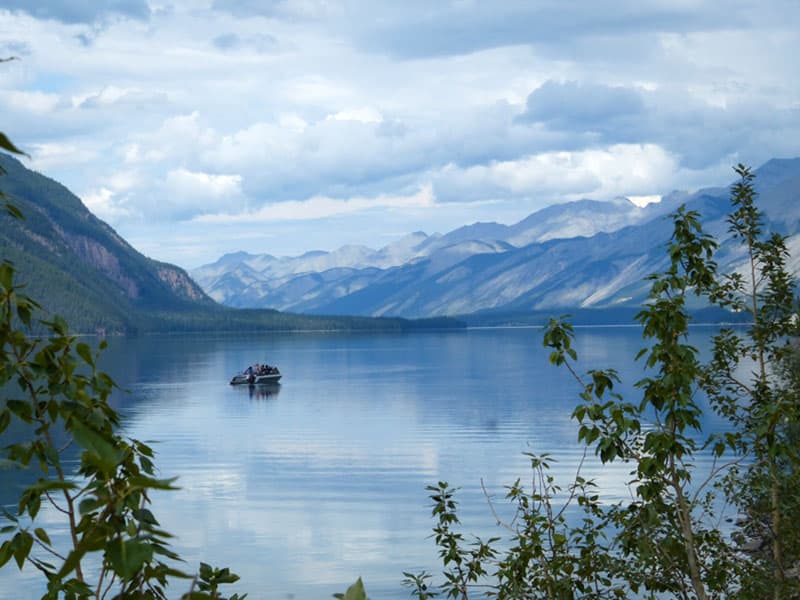
Above: Muncho Lake in British Columbia
We stopped at Muncho Lake Provincial Park for gas and found a pull over for lunch. What a breathtaking view of the lake and mountain scenery.
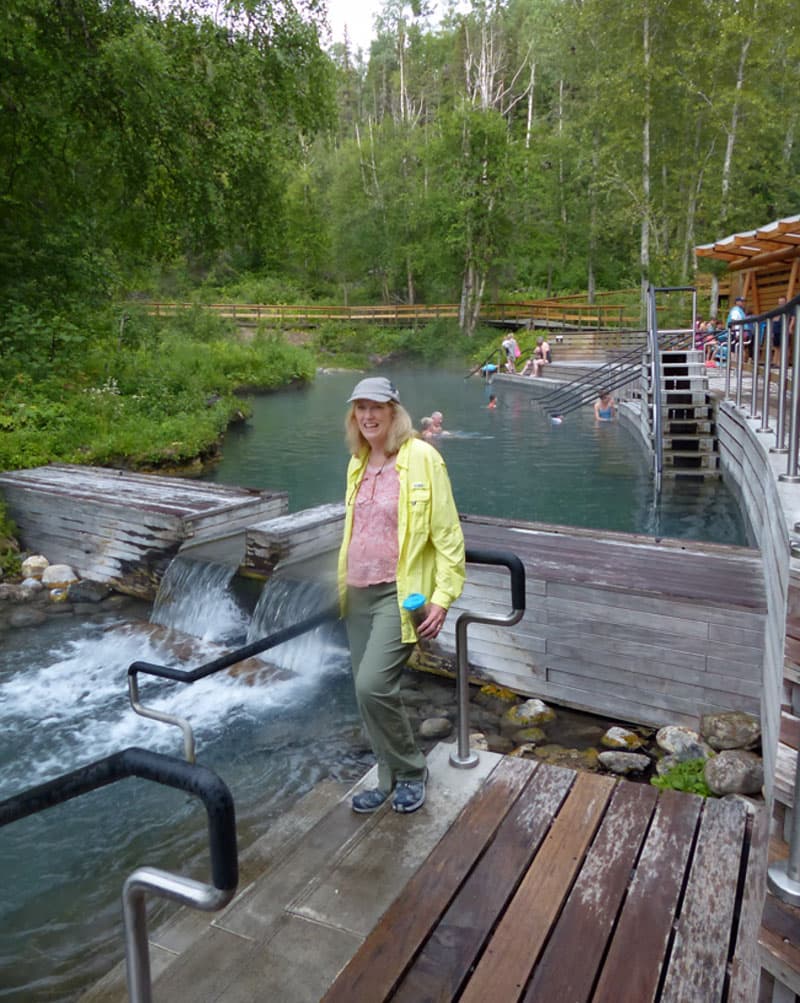
Above: Laird Hot Springs
Laird Hot Springs was a stop in the middle of nowhere. It was one of many destinations with no internet and limited services. After arriving at our campsite, we walked across the street to the provincial park to see the hot springs. We followed a 300 foot boardwalk through the lush picturesque muskeg.
On the way back, we spotted a large bull moose hidden behind the brush chomping on a tree. You could primarily see his nose and the rest of his huge body looked like a shadow. Most people walked right by without noticing Bullwinkle.
Crossing the road to return to our campsite, we spotted a large bison. We later learned that it is a free range bison area. Talking to some commercial truck drivers, we were told that drivers need to be very careful on that road in the winter as the beasts tend to form a group and sleep in the middle of the road, often camouflaged by the snow and looking like snow drifts.
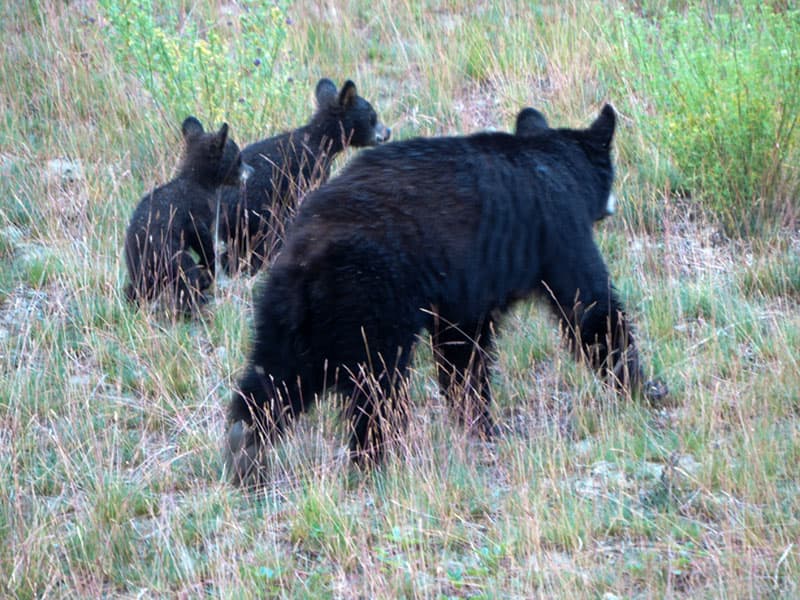
TCM: That would be terrifying, and potentially tragic. From your photography, you were very lucky to see a number of animals in the wild.
Dan: We enjoyed many encounters with various types of wildlife while on our adventure and it became a game watching for them.
Sheri has her camera with her at all times and does, “drive by shooting” so that not a moment goes by that she isn’t on the lookout for a photo opportunity. She sets the shutter speed to a high speed so that it stops the motion when driving. Photo stops must be limited or we would never get anywhere.
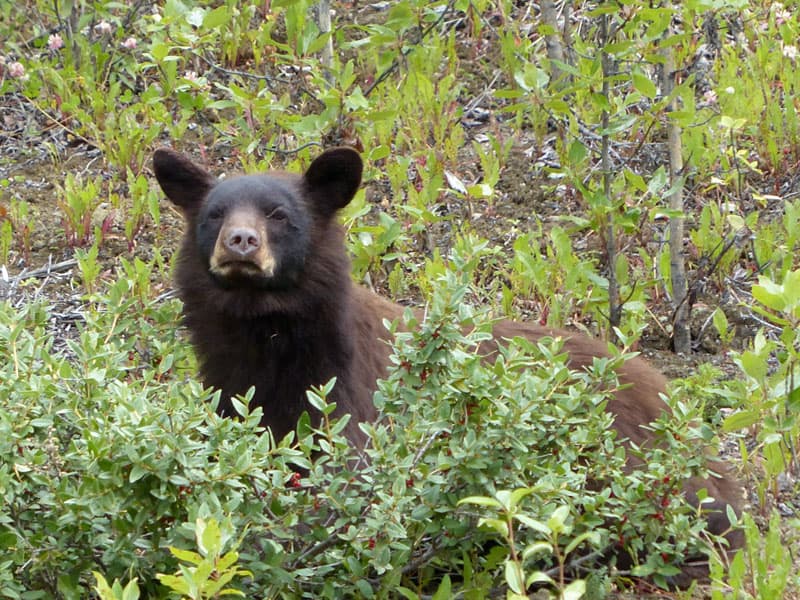
Sheri: One of Dan’s favorite bear encounters was a bear that we spotted on the way to Tetlin, Alaska. The bear was feasting on berries on the side of road with a bush camouflaging him. He was so engrossed that he wouldn’t look up even when Dan tried to get his attention so I could snap a picture of more than a shadow behind a bush.
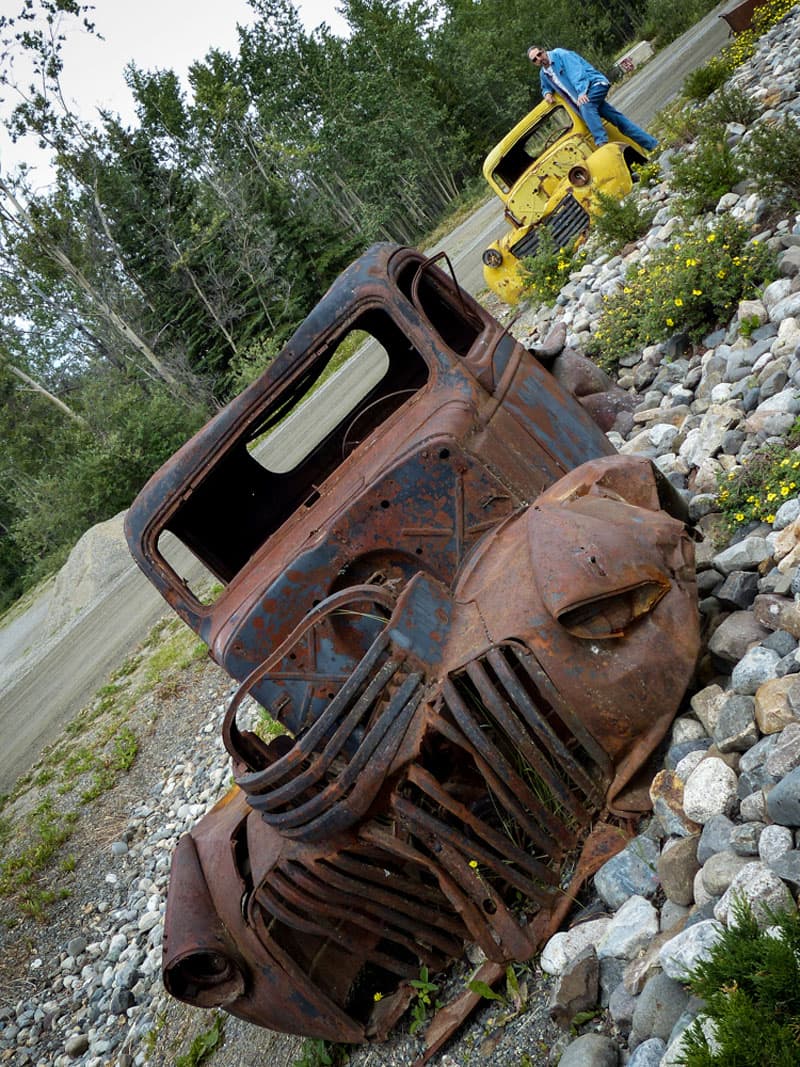
Above: Johnson City, Yukon, Abandoned highway construction vehicles
Dan: Between Tetlin and Whitehorse we discovered an old graveyard of 1943 construction vehicles close to Canol Road by Johnson Crossing, Yukon Territory. They had been abandoned after the construction of the road and left as a reminder of the project.
Sheri: After a supply stop in Whitehorse and a tour of the city, we took a scenic drive to Atlin, British Columbia. We headed down the South Klondike Highway to Carcross and then cut over to the Atlin Highway.
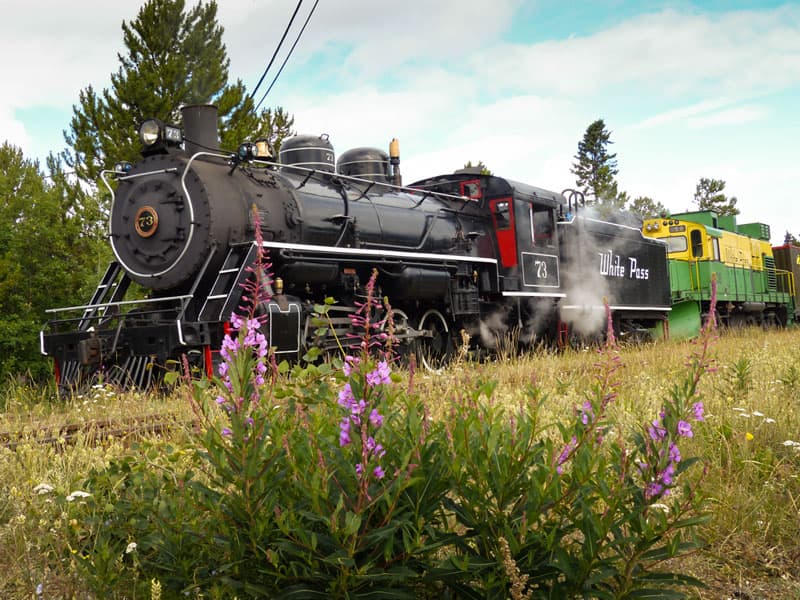
Above: White Pass Train, Carcross, Yukon
We enjoyed a stop in the small historic downtown Carcross, Yukon Territory. While there the White Pass train pulled into the station. This old steam engine’s route is the 67.5 miles from the port of Skagway, Alaska. The railroad began construction in 1898 during the Klondike Gold Rush as a means of reaching the gold fields.
We didn’t take the train ride, but we did enjoy a drive along part of its route later in our journey when we took the Alaska Marine Ferry from Haines to Skagway and drove back up to Whitehorse. The scenery between Skagway and the Alaskan Highway was amazing.
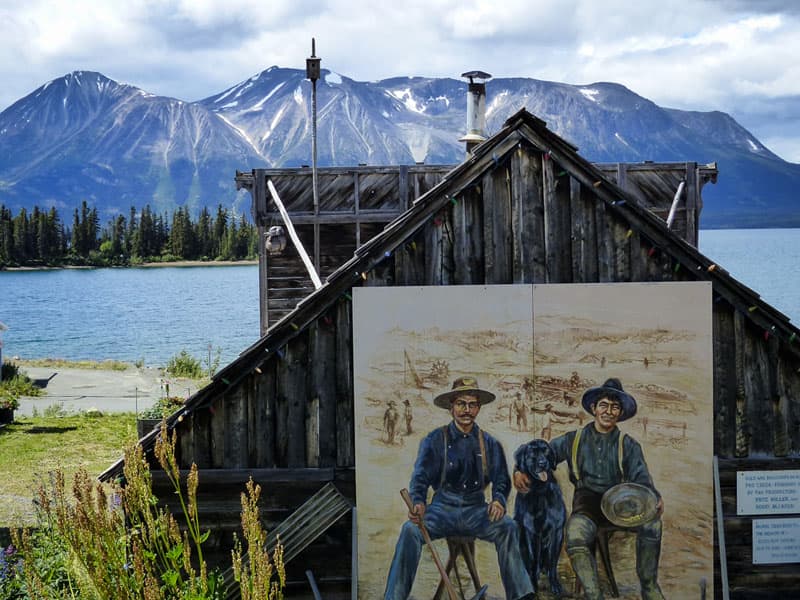
Above: Atlin, British Columbia, Gold Mine mural
We made it to the tiny town of Atlin, British Columbia’s most northerly town. It is a quirky little town on the shore of Atlin Lake, the largest lake in British Columbia. Atlin’s nickname is the “Switzerland of the North” because it is surrounded by mountains. It was full of lovely art and history.
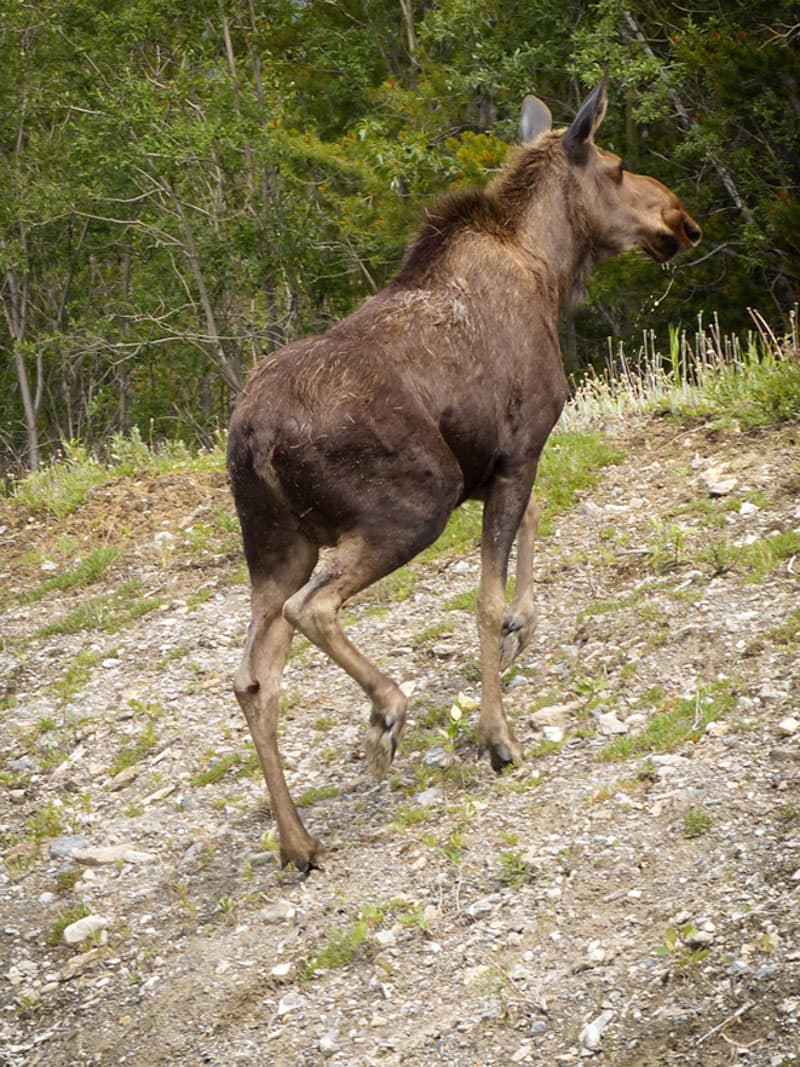
Above: Dan and Sheri enjoyed multiple moose sightings throughout our journey.
We headed up to Dawson City and took a ferry across the Yukon River to connect with the Top of the World Highway. The highway is a 79 mile long dirt road which twists and turns as it skirts the crest of the hills looking down on the valleys. We enjoyed the gorgeous scenic mountain drive even though it rained most of the day. For us, it was a long and winding muddy road.
TCM: Where did you cross into Alaska?
Dan: We crossed into Alaska for the first time at Poker Creek – Little Gold Creek Border Crossing. The border guard welcomed us home and stamped our passports; July 4, 2016. It was the only passport stamp that we would receive on our entire trip, despite the numerous border crossings along the way.
Sheri: Dan was optimistic at the border as the road was paved. The guard burst Dan’s bubble by telling him it would soon return to dirt. We continued on 42 more miles to Chicken, Alaska on muddy rutted roads.
When we arrived at the small community of Chicken (the full time population of 7 increases to 17 in the summer) we were running low on diesel. When we pulled in and the diesel pump was padlocked, Dan panicked thinking that they were out. That had happened a few times throughout our drive.
Fortunately, a gentleman ran out, unlocked it, and relieved Dan’s fear. He said that they lock the pump to prevent people from driving off without paying.
TCM: Did you often have trouble finding fuel on the trip?
Sheri: Dan began looking for fuel when our gauge reached three-quarters full. This practice was to prevent our fuel from reaching below a half tank. While there are fuel stops spread at reasonable intervals so that you likely won’t run out, there are also several places that may be out of fuel or are closed.
In a few instances the places were out of fuel. As a result, some fuel stops along the way may have long lines. Use the opportunity to take a break and patiently wait your turn. You never want to pass up a chance to fuel up even if your gauge reads three-quarters full! There is a reason for the long line.
Dan: My advice is always stop for fuel if your gauge reads three-quarters or less because you never know what’s ahead of you. That is an Alaska mindset for me because at any point in time if Sheri or I would see a road and wonder where one went, we went. You can’t do that if you have a quarter of a tank of fuel. If you want to be adventurous, I suggest you keep your tank filled.
Sheri: We use the Gas Buddy app. A couple stations in the Milepost aren’t there anymore because people went out of business or because they weren’t getting enough traffic. There were places we were counting on that didn’t have fuel.
DEF, (diesel exhaust fluid) was hard to find except in the bigger towns, so Dan had four to five jugs with us at all times. Trying to find DEF on the Alaskan Highway can be a challenge.
Dan: Most stations do not stock DEF because it’s a fairly new technology. Modern diesel engines require it to clean the exhaust. It’s just something I don’t want to worry about, so I always carry enough to get us to the next major town or city.
Sheri: Before we went up to Alaska I didn’t have any comprehension on how far away things were or that we wouldn’t have access to things we needed. We would stock up on food and supplies when we got to the larger towns.
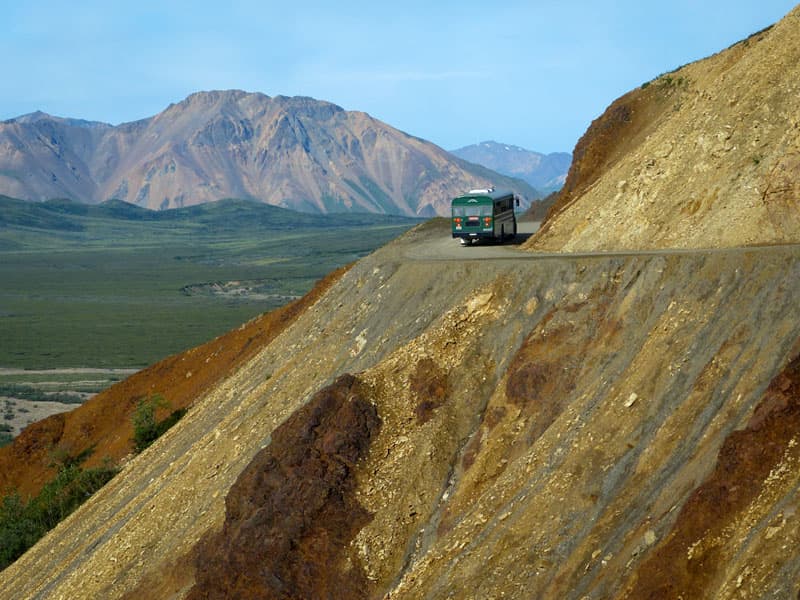
Above: Sheri and Dan took the eight hour bus tour through Denali
TCM: What were some of the highlights from your time in Alaska?
Dan: Denali National Park was a highlight. The six million acres plus in the National Park itself contains a variety of terrain, scenery and wildlife.
We took the eight hour round trip bus tour to the Eielson Visitor center. The park is bisected by one ribbon of road which took us quickly from flat terrain up to the top of the mountainsides with breathtaking views of mountain vistas and wildlife near and far. The road consists of sharp curves on the edge of the mountains. When a bus was approaching from the other direction, one had to pull over to let the other pass safely.
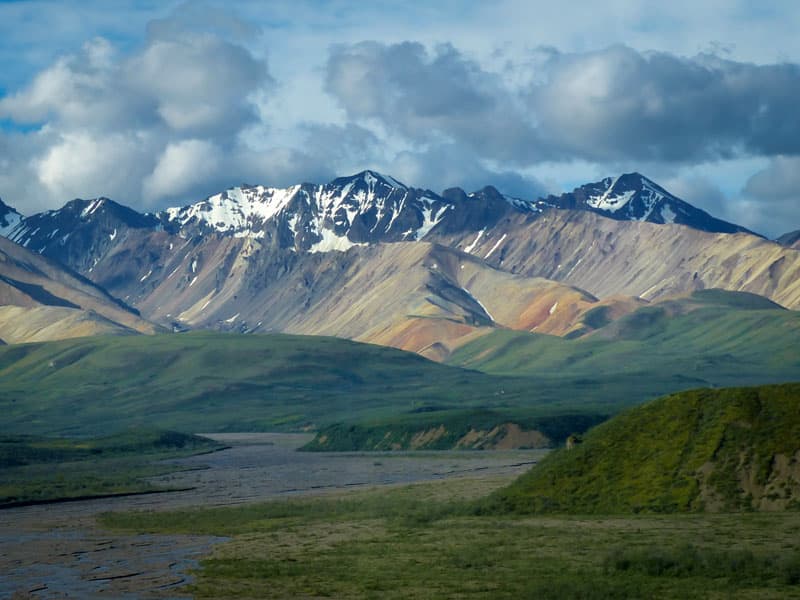
Passengers are guaranteed to see wildlife along the way. While many of the bears and goats are far in the distance, we saw an abundance of reindeer/caribou along the way.
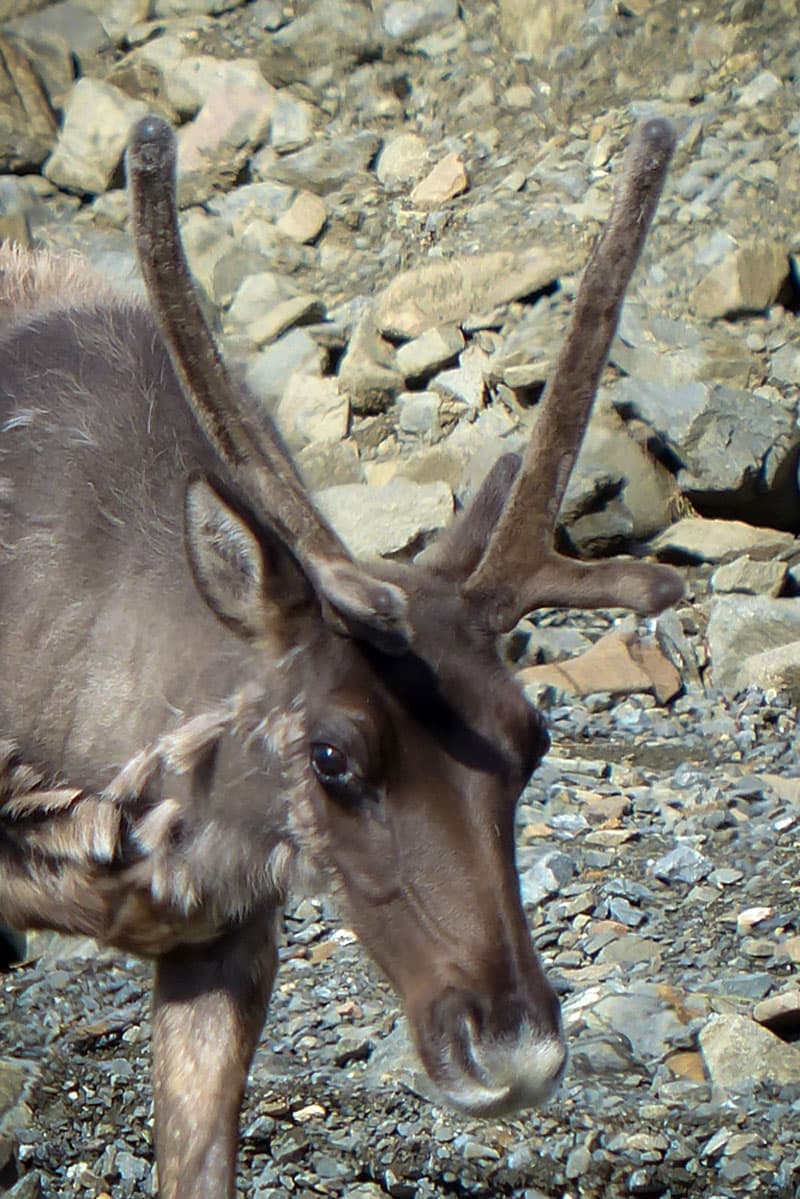
This fellow was drinking from a stream on the side of the road. He still had tufts of his winter coat to shed.
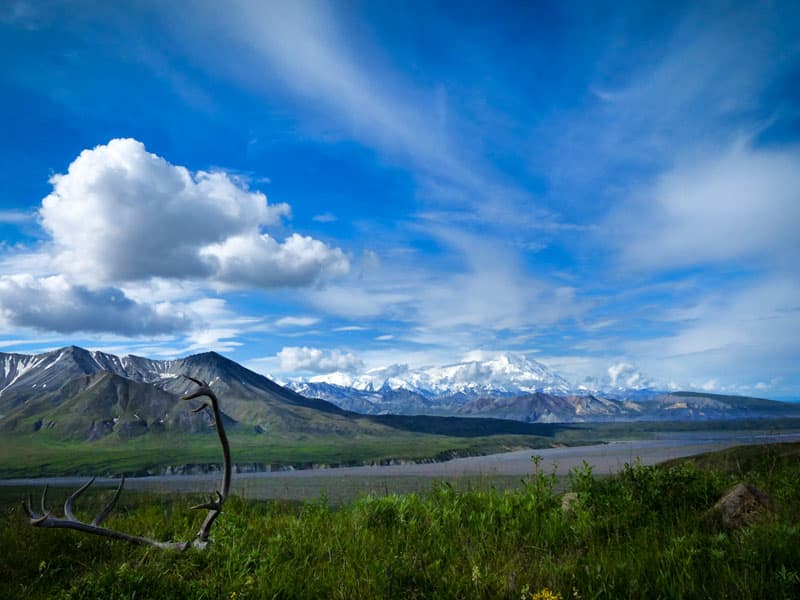
When we reached the viewpoint of Denali it was amazing. The clouds covered the highest elevation of the snow topped mountain.
Sheri: Another standout was the Kenai Peninsula. Unfortunately, we managed to arrive just in time for one of the busiest times of the year.
The salmon were running and it was the one week that native Alaskans are allowed to fish using dip nets. The fishing camps and campgrounds were overflowing with fishermen dreaming of filling their coolers with fresh caught salmon.
We booked our campsites as we went, typically a few days in advance. Often because of our small footprint campsites were able to squeeze us in. That wasn’t the case on the Kenai while the salmon were running.
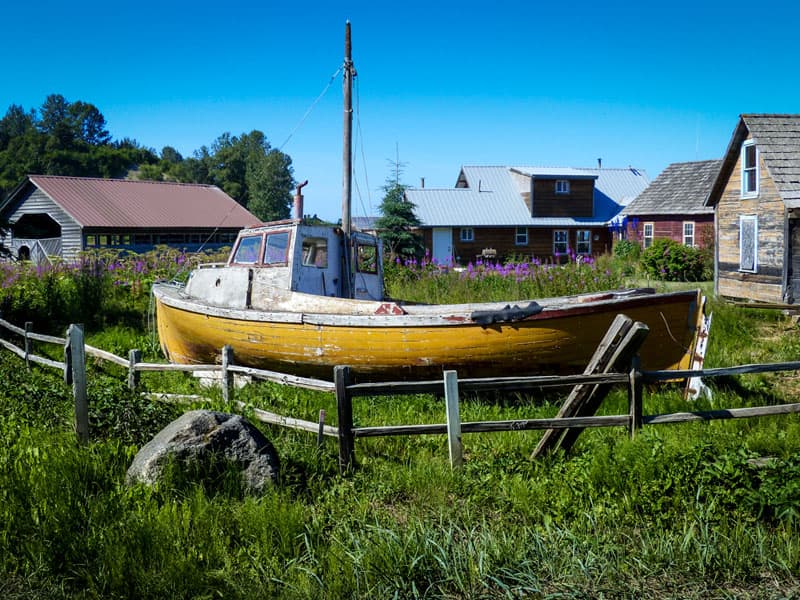
Above: The old fishing town of Ninilchik was established by Russians in 1847
We stayed at a small halibut fishing camp in the Russian fishing town of Ninilchik. We had a lovely view of Mount Redoubt (10,197 feet) across Cook Inlet from our campground. Cook Inlet has a series of volcanoes which are part of the “Ring of Fire” providing a spectacular scenic backdrop and some of the best Halibut fishing around.
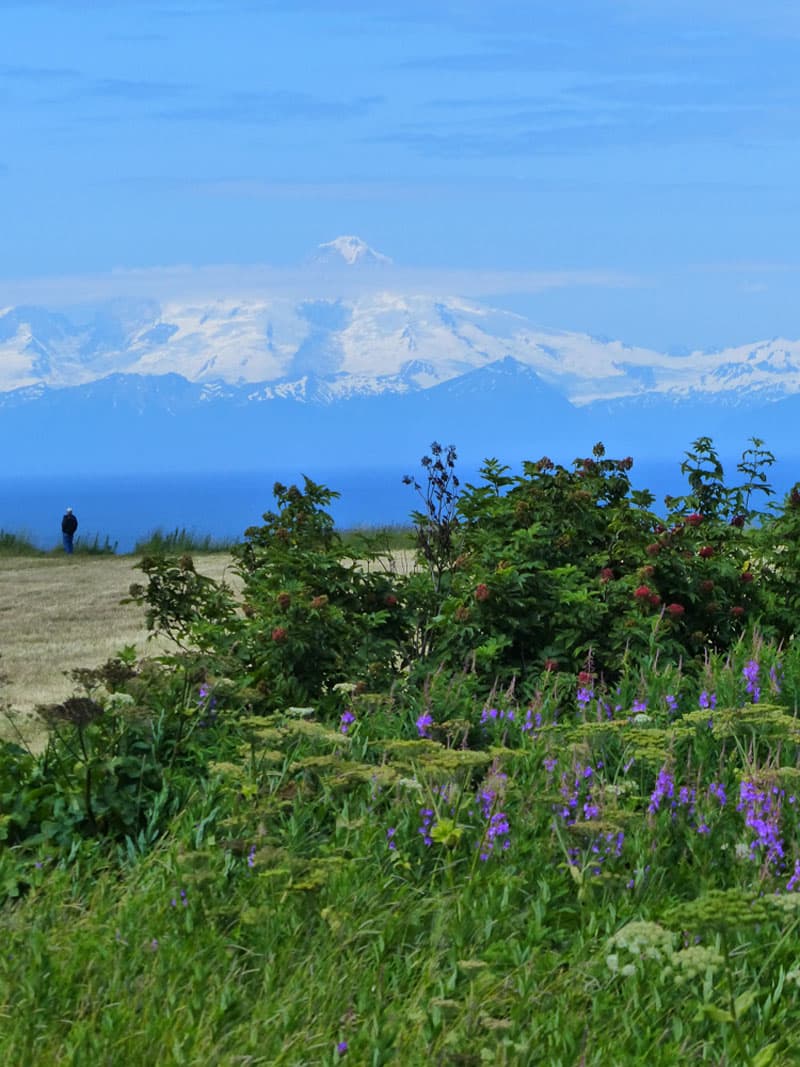
Above: Mount Redoubt (10,197 feet) across Cook Inlet from the campground
Dan: We used Ninilchik as a base and explored Homer and surrounding areas on the Sterling Highway. Homer is surrounded by spectacular scenery, including the Kenai Mountain Range beyond the Kachemak Bay on one side and the Chigmit Mountain Range across Cook Inlet on the other. We enjoyed several scenic drives through the country side and downtown.
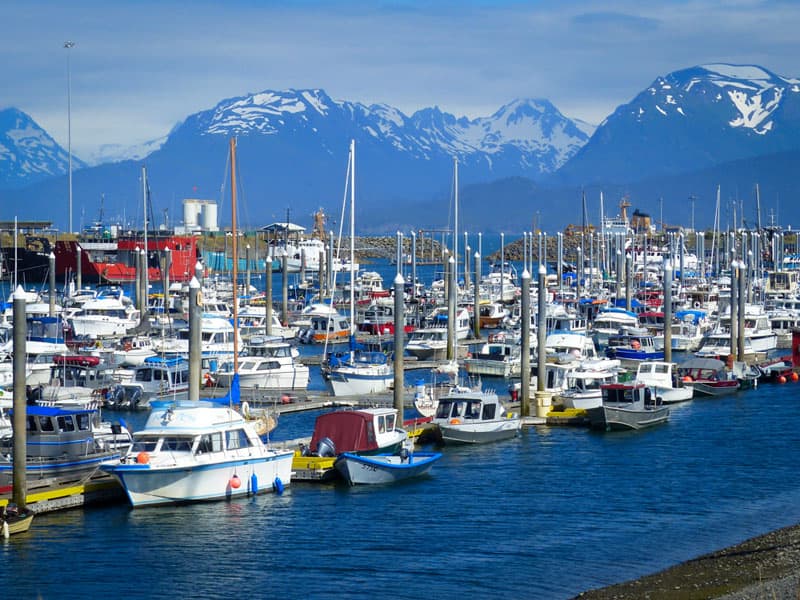
Above: Homer harbor, Alaska
We drove down the famous Homer Spit, a 4.5 mile peninsula jetting into the bay. It was a little too congested for our tastes. While we were there we saw a huge RV park right on the water, which would give easy access to everything there is to do on the spit.
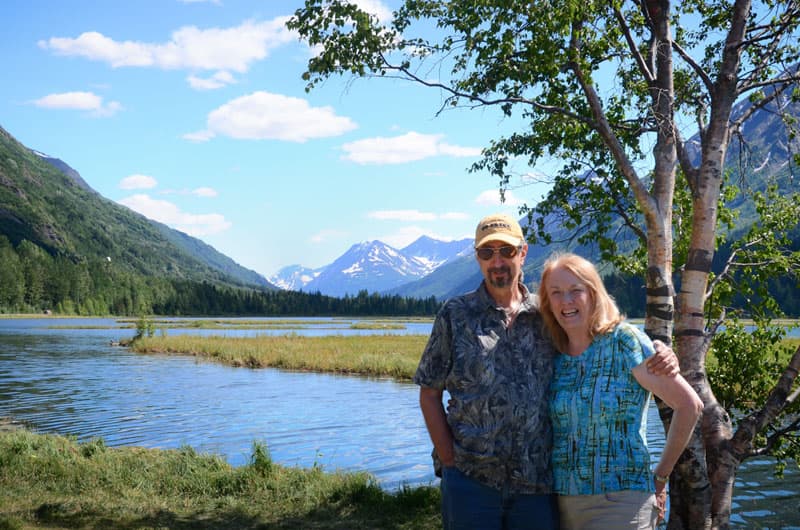
Sheri: Seward, Alaska was one of our favorite places because of its artsy feel and quaint town ambiance. We avoided the areas close to the cruise ship docks.
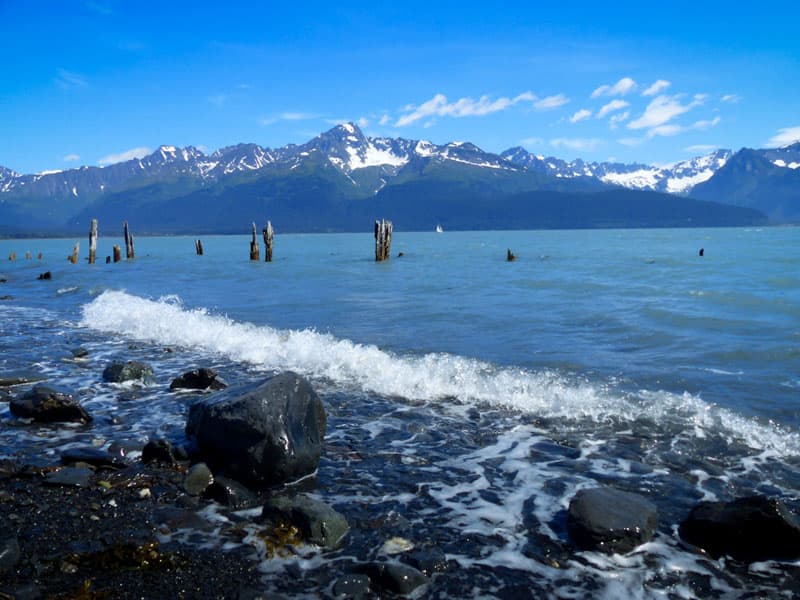
Above: The shores of Resurrection Bay with Mount Marathon
We enjoyed walking along the shores of Resurrection Bay which is flanked by rugged mountains and a breathtaking view of Mount Marathon. The marker for Mile 0 of the 1,200 mile Iditarod trail was in a park by the bay.
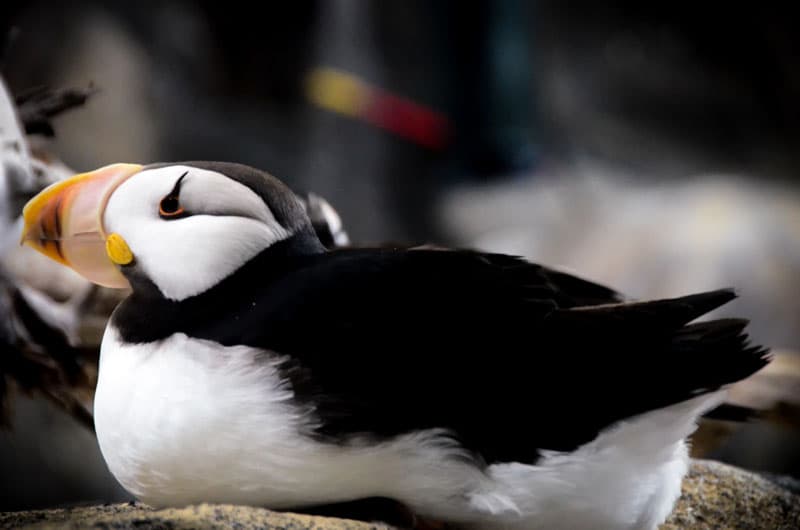
Above: A puffin at the Alaska SeaLife Center
One of my favorite places in Seward was the Alaska SeaLife Center. The SeaLife Center is Alaska’s premier public aquarium and the Alaska’s only permanent marine mammal rehabilitation facility. We enjoyed seeing the sea life, mammals, birds, and particularly, the Puffins, up close.
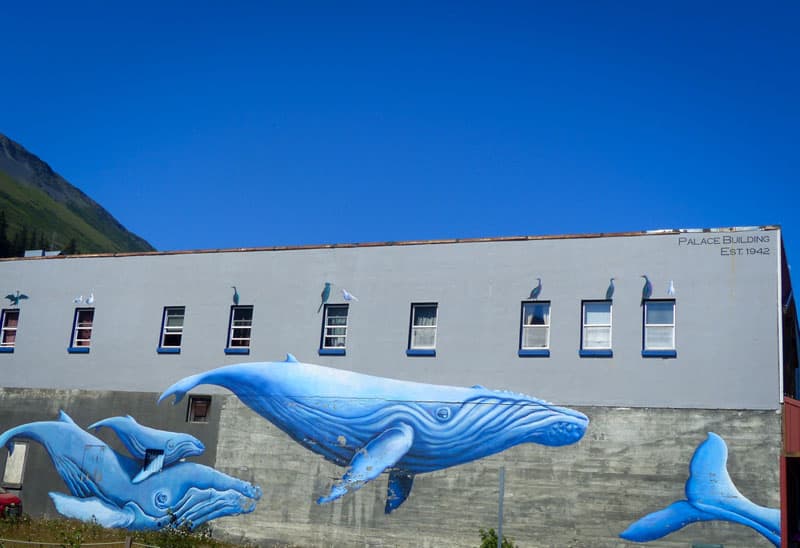
Dan: Seward is the “Mural Capital of Alaska” with over 30 murals throughout the town on the sides of buildings. Sheri made a point to seek out and photograph each magnificent one. The Seward Mural Society adds at least a new mural each year.
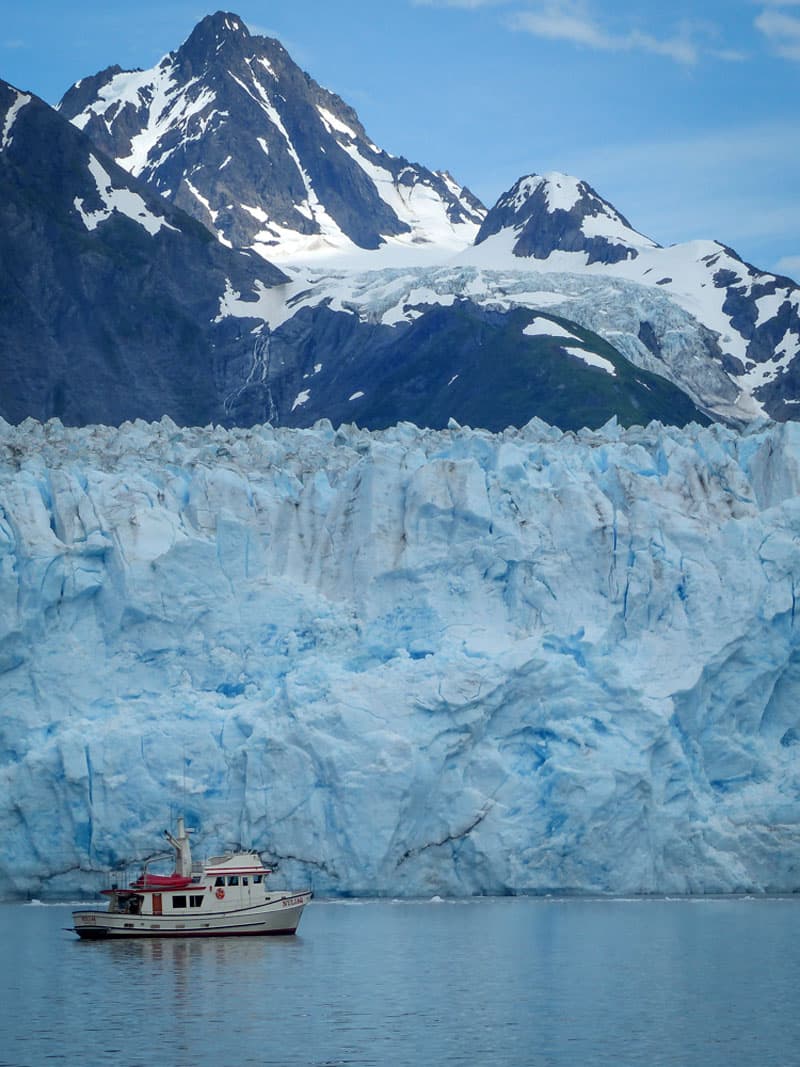
Above: Meares Glacier, Valdez, Alaska
TCM: Are you planning to return to Alaska, or do you have other truck camping plans now?
Dan: We had the most amazing Alaska trip and plan to return and stay longer next time. Our sixty day trip flew by with every day having a new adventure and thrill.
Our truck camper served us well. Upon our return to Arkansas, the lifestyle transition from our truck camper back into our spacious home took a little getting used to. We are looking forward to our next adventure and definitely plan to return to Alaska.
TCM: Did you use any books or guides during your trip?
Dan: Yes, we did. We used The Milepost, Travelers Guide to Alaskan Camping, and Ron Dalby’s Guide to the Alaska Highway. We also used online apps including Allstays Camp and RV, Yelp, and Trip Advisor.
Sheri: We had membership to Passport America, which we never used in Alaska. We used Good Sam campsites frequently and got a discount at most places.
We also had a roadside assistance plan with Coachnet. We needed their help while on the road, but unfortunately our calls were put on hold for thirty minutes each time and we never got to speak to anyone. We have since cancelled our service. Coachnet eventually refunded our money. Now we only use AAA because our vehicle is better protected with AAA no matter where we are.
TCM: Earlier you mentioned that it is better to not go in high summer season. You also said that Lake Louise was jam packed with people and that the Kenai Peninsula was busy. Did you find campgrounds to be booked?
Dan: Plan your campgrounds; especially in June, July, and August. There are so many caravans that go to Alaska and so many baby boomers with RVs. When they roll in, they consume all the spaces. If you are going to stay in campgrounds, you need to plan your trip accordingly.
We primarily stayed in private campgrounds. There is not always cell service or internet so it’s important to make advanced campsite reservations, especially for popular locations or locations with limited campsites. Most of the time you can book a night or two ahead when you know where you are going to travel.
For popular destinations and on weekends it’s good to book as far in advance as possible. Most of the national and provincial parks book sites well in advance. If they don’t take reservations, they operate on a first come first serve basis.
Sheri: We called a week and a half in advance for Denali. There was a caravan there when we arrived. With bigger rigs it’s much harder to travel and be spontaneous about your desired destinations.
Dan: If you are the type of RVer who likes to primitive camp, you will have no trouble at all boondocking in Alaska. Canada, on the other hand, has a lot of restrictions on places you can dry camp, especially along the highways. In Alaska, for the most part, if you can find an open space, you can stop and boondock.
Sheri: July 10th marks the beginning of dip netting season for Alaskan residents. To dip net, anglers stand in the mouth of the Kenai River holding large nets with long handles. Dip netting is open to Alaska residents exclusively on the Kenai Peninsula until July 31st and that’s when we unknowingly went there. It was packed.
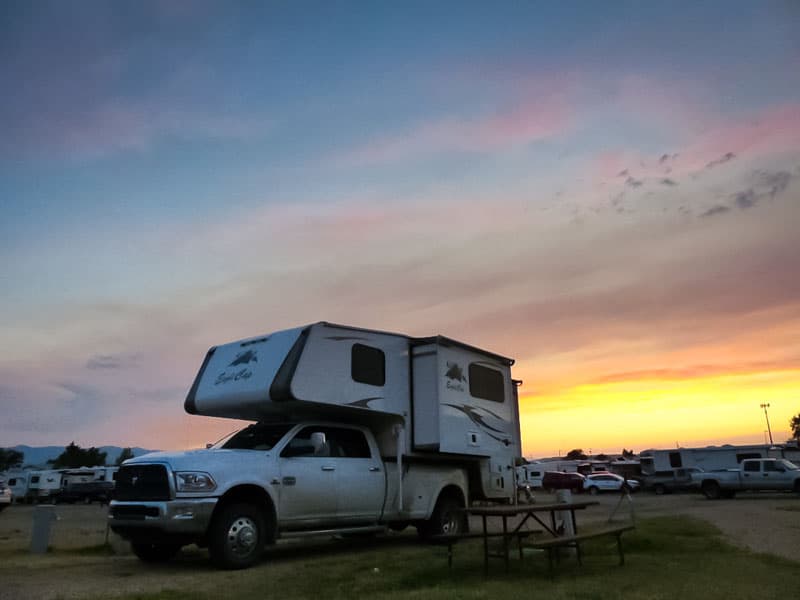
Above: Sheridan, Wyoming sunset
TCM: Is there any equipment that you recommend truck campers take with them to Alaska?
Dan: For those who do a lot of off-roading, bring two spare tires. If you want to take the Dempster or Dalton highway to the Arctic Circle, some recommend three spare tires. However, if your truck is equipped with Load Range F or better commercial grade tires, you’ll be fine with one spare as these tires are built for endurance.
Be sure to bring an air compressor. We can recommend the Viair Air 400P-RV automatic portable compressor. With the changing temperatures, we had to adjust our tire pressure often.
I recommend a Truma Propane Level Check. It’s a sonar measuring device that monitors your propane levels through your tank’s wall. Propane is not always readily available in Alaska. Some retailers ran out, or their propane pumps were broken. It’s good to be aware of your propane consumption and to fill up when you can.
If your diesel engine requires DEF, we recommend bringing extra containers. We found DEF at Canadian Tire and auto part stores in larger towns. Some gas stations in Alaska had it, but not many.
Use bug wash windshield washer fluid instead of regular to help keep your windshield cleaner. And install bug screens on your truck grill to protect your cooling system from bugs and rocks.
TCM: Do you have any other tips for folks who are considering a truck camping trip to Alaska?
Sheri: Stock up on your favorite food staples because they will likely be more difficult to find in Alaska’s smaller markets. During our trip we primarily fixed our own meals. We were able to replenish almost anything we needed in the larger cities.
Dan: We used our freezer for meat vacuum-packed in serving sizes. Sheri cooked mainly in our Instant Pot electric pressure cooker. We packed our own lunch most days and picked scenic locations to eat.
Sheri: There were plenty of dirt roads and areas with road construction. The worst hazards are the sudden dips, frost heaves, and uneven roads on the paved roads. In many areas they put small orange flags or cones to mark the various road hazards. Pay attention to these orange flags and slow down.
After several days of driving in the rain and muddy dirt roads, we gave up on trying to keep the outside our camper clean of mud and tar. Dan’s bug screens did a good job of collecting a large variety of insects.
I also recommend talking to the people at the visitor’s centers. They are really friendly. Ask them what the must see places are. We’d get out a map and they would show us points along the way.
I am into history. Dawson City’s visitor center, as well as many of the others, had movies that tell the history or some unique story about each area. Knowing the history will add to your appreciation of Alaska.
I am a photographer, so I also ask about scenic places. In Dawson Creek there is a bird sanctuary. On the way you see fields of yellow canola. There are boardwalks through a swamp like area where ducks breed. We were the only ones there. That was a recommendation from the visitor’s center.
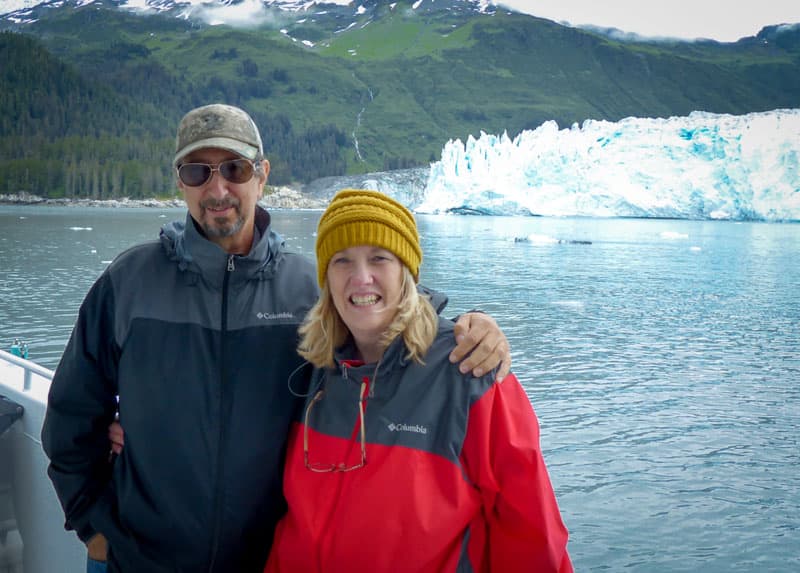
Above: Dan and Sheri in front of Meares Glacier, Valdez, Alaska
TCM: Looking back, how has Alaska changed since your first visit?
Dan: Forty-five years ago, they were just bringing in the equipment for the pipelines and there were no major cities. Even Whitehorse was just a little small town. What blew my mind this time was how much progress has impacted that area. Fairbanks is a bustling cosmopolitan city, and so was Anchorage.
Now almost every main road is paved and there are nice facilities along the highway. It’s almost like driving anywhere else in the western part of the United States. Back in 1971 it was pure wilderness. It was much more of an adventure.
Today, once you get off the highway, you will be in the wilderness. Be prepared for it. There’s no one out there who’s going to get to you quickly.
You will lose cell phone service regularly. We had considered renting or buying a satellite phone, but we found that we didn’t need it. We were smart about how we kept our truck fueled and planned our trips day to day.
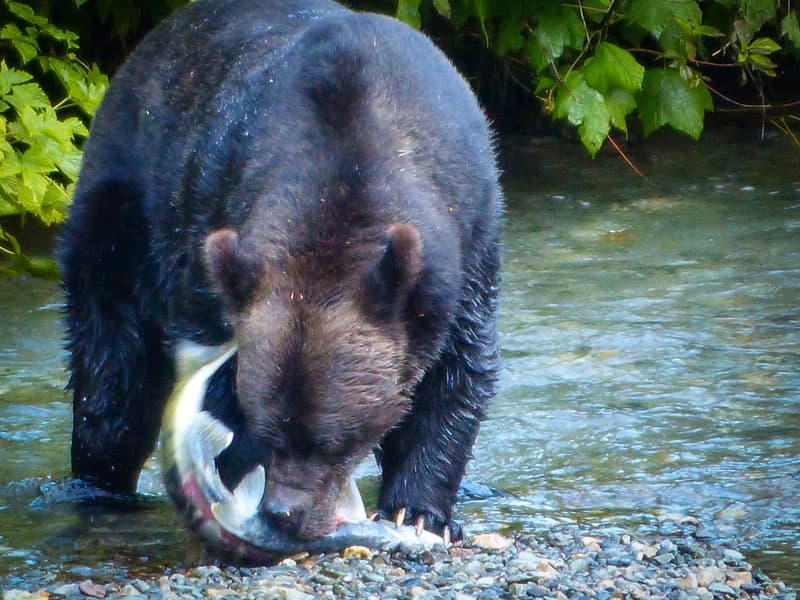
Above: A bear eating salmon in Hyder, Alaska
Sheri: It’s unimaginable how spectacular Alaska is. It was mountain after mountain, beautiful green lakes, cliffs, and wildlife. It was more incredible than I could have imagined. Everything had some unique and incredible aspect. Every turn took our breath away.
Dan and Sheri’s Rig
Truck: 2015 Ram 3500, crew cab, diesel, dually, 4×4, long bed
Camper: 2015 Eagle Cap 1165
Tie-Downs and Turnbuckles: Torklift Fastguns
Suspension: Torklift StableLoads and airbags
Gear: Viair 40047 400P-RV automatic portable compressor kit, tool kit, plumbing repair kit, extra lengths of sewer hose, potable water hose, black tank flush hose, extra DEF (Diesel Exhaust Fluid), replacement wiper blades, military folding shovel, ratchet tie-down binders, something to black-out the windows with 18 hours of daylight, Bug Wash windshield washer fluid











